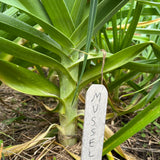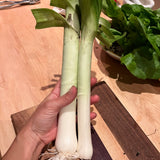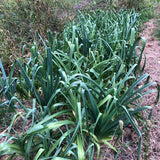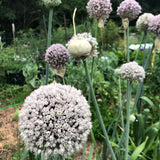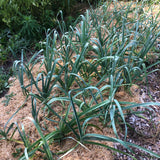Giant Musselburgh Leeks
Allium ampeloprasum
Sometimes called "Scotch Flag" leeks, this Scottish heirloom was introduced in the early 1800s, and is traditionally cooked in soup and stews. Check out this recipe for a traditional Scottish favorite, Cock-a-Leekie soup, for inspiration! Cock-a-Leekie soup features chicken, leeks and veg, rice and dried prunes.
These leeks grow to be huge, with white stalks 2-3" thick and beautiful, blue-green leaves about 9-15" long, which whorl out in a fan shape. The flavor is smooth, mild and tender. Leeks are a frost-hardy cool season crop, and this is one of the best winter hardy leek varieties! A late bolting variety, lovely for bunching for market gardens. Hardy through zones 3-11.
Our grower Katie Ruppel says: This leek variety grew the best out of three varieties I trialed in 2019. (I was looking for root strength, drought tolerance, size, and cold hardiness). It overwinters very well, in my zone 7a and I was still harvesting in April with no winter protection for the plants.
Days to maturity: 120
Seeds per pack: 180
Germination rate: 89% on 01/01/2025
Planting / harvesting notes
For spring planting, sow seeds indoors ¼–½" deep and space 1" in all directions, 8-10 weeks before last frost. Transplant as soon as soil can be worked in spring. For overwintering, direct sow in late autumn, 2-4 weeks before last frost. Plant in full sun, well-draining soil, and water consistently. Some growers plant leeks in trenches, and mound the soil around the stems several times throughout the season, to blanch leek stalks as they grow and encourage height. Harvest late summer to early fall.
Seed keeping notes
Biennial, flowers/produces seed in second year. After overwintering, the leeks start to bolt in June, flower through July and seeds begin to ripen in August. Seed heads are ready to collect in September when dry. After drying further in paper bags, whack and rub the heads into a bucket to remove the seeds. Spread it all on a baking sheet and carefully use a heavy marble rolling pin to separate the chaff from the seeds. Lastly, winnow the seeds from the chaff.






